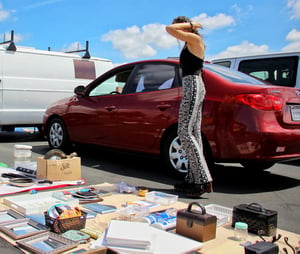When it comes to decluttering the home – time is key.

If you have only days (or hours) until your lease expires or you need the items gone, you’re likely limited to dropping everything off at the local dump or second-hand store. If you have the luxury of time, there are more options.
I tried my hand at selling at Denio’s, a Sacramento area flea market, and the experience was – well, honestly amazing. I also learned a few things along the way that I wanted to share to make it a success for you, too.
Segregate your sell pile
I highly recommend finding a place to store the items you want to get rid of and separate them according to category: things you want to sell, donate, or throw out. It’s best if it’s an area where the pile won’t bother you over the mid- to long-term, but even just a corner of your living room can work in a pinch.
Select what you’ll bring
What I did – and I highly recommend – is bring smaller items, not larger ones. My logic was that I could post a photo of a dresser, or even a mirror, to Craigslist and someone would come pick it up. However, nobody is going to drive to my house to buy a single mug or old cooking pan. I brought an entire car-full of smaller items – and sold nearly all of them.
Prepare the night before
So the big catch with flea markets is – and if you’re a night owl, I’m so sorry – you need to arrive by 5:30 a.m. to set up your booth. If you’re late, you may lose out on a prime spot and in some cases have to pay an entry fee. To make my super early morning as hassle-free as possible, I prepared everything possible in advance.
- Pack your car the night before – or leave items in boxes near the door if they wouldn’t be safe in your vehicle.
- Set the coffee maker (essential, for me).
- Prepare a breakfast and a lunch (I made the mistake of just bringing breakfast) – you will be there from 5:30 a.m. to late afternoon. If you don’t bring enough food, you’ll end up eating from a food truck – not a problem, but keep in mind any expenses incurred at the flea market will cut into your profit.
Setting up your booth
“Booth” is actually a bit of a glorified way to describe how I presented my space – I did not have a pop-up tent or card table. Ultimately, I went with the extremely simple method of laying two blankets on the ground. My No. 1 advice is to not be afraid to re-evaluate and change your display as the day goes on. I initially organized my items by function or whatever I felt made sense, but by the end of the day I had them organized by price, which I felt worked well.
Running your shop
There are two parts of running your mini “shop”: making sales and managing all the downtime when there is nothing to do. Believe me, there is a lot of down time. As far as how I killed most of the time, I read, talked to people, listened to music, or looked bored. I did a little bit of all four.
Regarding pricing, I found that things sold better when priced at even numbers. I sold things best at $4 and $6 rather than, say, $5. As the day went on, I became more flexible with my prices. I also reorganized items based on price. By the end of the day, one blanket became a “$1 or less” section, which really sped things along. Make your “booth” inviting to customers. I got a lot of compliments on the music I played over my speakers (REO Speedwagon, Janis Joplin, and Sly & The Family Stone), so I ended up incorporating the fact people loved my music into my sales strategy. When people approached my area, I told them “everything on the right is $1 or less, everything on the left we can haggle over, and the music is free but it’ll keep you looking!” It went over very well. Once I got people laughing, they were far more likely to purchase something.
Conclusion
In the end, I made $150 over 10 hours – so I suppose I should give myself credit for hitting California’s new minimum wage standards. It’s worth noting that I made $100 over the first eight hours or so, and about $50 in the last two hours once I reorganized my items by price and honed my sales pitch.
A booth costs between $20 and $30 for the day. Be sure to factor that into your overhead, and make sure you feel you have enough items to recoup those costs so you’ll make a profit. You can also always keep an eye online for a free community garage sale days – if you have a place to store your stuff until then. I’ll be honest: if I made even $50 over 10 hours, I still would have considered that a win if not just for how much fun I had. Afterall, making even a little bit of money, as opposed to spending it on other weekend activities, turned out to be a great way to spend a Saturday!



